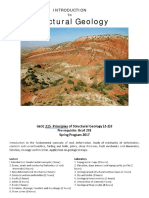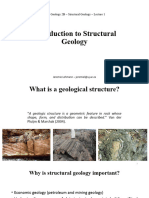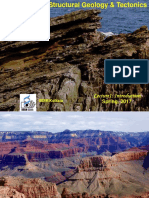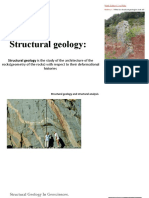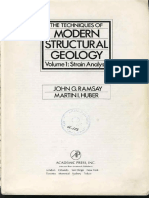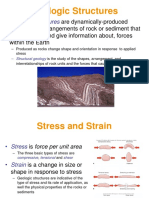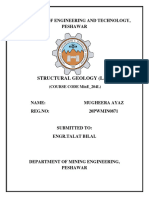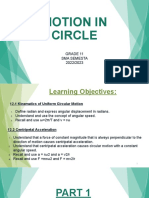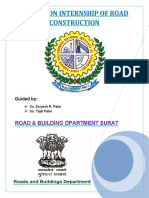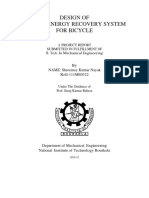Welcome to
Theme 1
STRUCTURAL GEOLOGY
GLY 365
Introduction to Structural Geology and
Structural Analysis
Lecturer: Prof. Adam Bumby
Rm. 3-51/3-53, Mineral Science Building
Read: Fossen Chapter 1, V&M Chapter 2,
D&R p.645-662
Structural Geology: what’s it all
What is a secondary structure?
about? Primary structures form prior to lithification
• It is the study of how and why rocks deform Pahoehoe (Ropey lava
• Molten lava structure) in Hawaii and
• Deformation can be recognised in rock by the Marion Island: an example
presence of ‘secondary structures’ that we can • Unconsolidated sediment of a primary structure in
volcanic rocks.
identify and measure in the field (surface
outcrops and mine excavations).
• Geologic structure: ‘A geometric configuration of
rocks’. (Fossen)
• The study of ‘architectural forms’ that have
formed in the Earth’s crust as a result of
deformation. (Davis)
Primary structures: those which form while
the rock is forming Trace Fossils
Secondary structures: those which form
after the rock has formed
Bedding planes:
Primary
structures in
sedimentary
rocks
1
� Primary or secondary?
Cooling joints in basalt
(‘columnar basalt’).
Trace Fossils being made….in SOFT sediment.
So do primary structures tell us
nothing about deformation?
Steeply-dipping
and overturned
strata in the
Lufilian Arc (DRC)
Note the important relationship between structural geology and PLATE TECTONICS.
Change in
• What do we mean by deformation? Change in
location orientation
Changes that take place in the original
location, orientation, volume and shape of a
body of rock
Any body of rock will deform if conditions
are right
Change in
Conditions: e.g. temperature, pressure, time Change in
shape
volume
If a rock has been deformed, it shows strain
The rock is strained as a result of stress.
2
� The strain in rock is generally imposed by the
stresses that relate to
PLATE TECTONICS
(e.g. consider the example from the Lufilian Arc)
Consider also:
Intrusion of magma bodies
Meteorite impact
Salt tectonics
(These are geological examples that are not
directly related to plate tectonics)
Vredefort Dome, near Parys, Free State: deformation due to meteorite impact
Gravity-driven vertical movement of salt induces folding in strata. What parts of the Earth does a
structural geologist consider?
• The cool, outer part of the crust (<10km
below the surface). Area of brittle
deformation
• The warm, lower part of the crust (>10km
below the surface). Area of ductile
deformation
• Underlying Earth’s mantle
(Example from offshore Brazil)
3
� There are two ways in which a
rock can undergo deformation:
Brittle Deformation
(= fracture)
Ductile Deformation
(= flow)
Butter-Basher experiment
The depth in the crust (i.e. the temperature) is a Effect of different
major control over these types of behaviour temperatures
The importance of Structural
What are the methods?
Geology
• Structures affect the style of mining. e.g. bad • Field observations (direct measurement
ground, missing reef, duplicated reef from rocks).
• Discontinuities in the rock are an important civil • Remote Sensing (Satellite imagery, aerial
engineering variable (e.g. predicting rock falls in
cuttings and tunnels) photos, DEM, GPS, GIS, Google Earth).
• Structures affect the flow of oil. Where can it be • Laboratory experiments (e.g. Sand box
found? How can oil/gas be removed? experiments, Donath aparatus,
• Development of ‘tectonic models’: how do small Microscopy)
scale structures relate to large-scale processes • Numerical Models
operating on Earth.
• Geophysical methods
Aerial Photography and Satellite
Imagery: Increasingly large-
scale provides increasingly
detailed structural information.
Field Measurements
4
�Digital elevation models (DEM) of the western limb of the Bushveld Complex
Data from stationary GPS units indicating relative plate motion and strain rates in Asia
Triaxial deformation experiment: laboratory-induced deformation band
Early Sand box experiments
Microscopy: SEM of a deformation band
Geophysics: Marine Seismic Acquisition
Note the well-developed angular
unconformity suggesting a period of
deformation.
5
� Geophysics: Gravity and Magnetic maps of Minnesota, USA
(Most areas are covered by glacial deposits)
How can we treat data?
Structural Analysis:
1. Geometric analysis: Identification,
measurement, representation (e.g.
stereographic projection)
2. Kinematic Analysis (Strain)
3. Dynamic Analysis (Stress)
Stress goes away, but strain
remains present (fold etc)
and can be measured
A non-geological example: detailed structural analysis of deformed pizza:
What does a structural geologist do?
1. Recognises secondary structures
Measures those structures
(=geometric analysis)
2. Recognises the movements that
occurred during deformation
(=kinematic analysis)
3. Interprets the forces, stresses and
mechanics that produced the structure
(=dynamic analysis)
1.+2.+3.= detailed structural analysis
Geological Examples:
Kinematic analysis: Slickenside lineations
in Corinth (Greece) show that this rock
has undergone strain
Geometric Analysis: Mapping
and stereographic projection.
6
�Dynamic Analysis: What forces, Revision of fundamental concepts
and from what direction caused
this folding? Large-scale
Structural Analysis= Tectonic
analysis Types of geological contacts:
sedimentary contacts
angular unconformities
disconformities
nonconformites
intrusive contacts
faulted contacts
shear zones
Disconformity Siccar Point, Scotland
(The world’s most
important geological
exposure?)
Angular unconformity
Nonconformity
Red Sandstone and
conglomerate
(Continental sediment)
Onlap/ buttress unconformity Greywacke
(Marine sediment)
Revision of fundamental Pumpelly’s Rule
concepts
Doctrine of Uniformitarianism
Law of Superposition
Law of original horizontality
Law of cross-cutting
relationships
Pumpelly’s Rule
Small-scale structures mirror large-scale structures.














